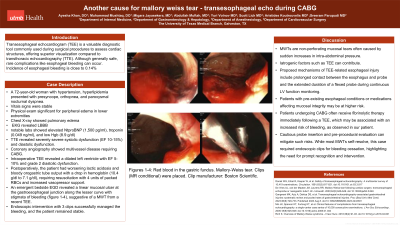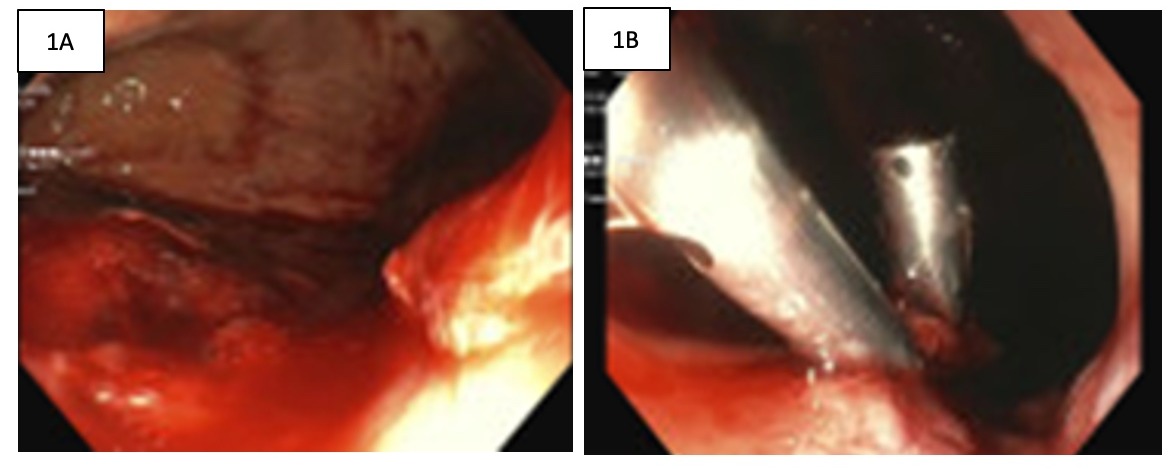Tuesday Poster Session
Category: Esophagus
P4013 - Another Cause for Mallory-Weiss Tear: Transesophageal Echo During CABG
Tuesday, October 29, 2024
10:30 AM - 4:00 PM ET
Location: Exhibit Hall E

Has Audio
- AK
Ayesha Khan, DO
University of Texas Medical Branch
Galveston, TX
Presenting Author(s)
Ayesha Khan, DO1, Muhammad Mushtaq, DO1, Migara Jayasekera, MD2, Abdullah Muftah, MD1, Scott Lick, MD1, Yuri Volnov, MD3, Aristides Koutrouvelis, MD1, Sreeram Parupudi, MD1
1University of Texas Medical Branch, Galveston, TX; 2University of Texas Medical Branch, Houston, TX; 3UT Medical Branch, La Marque, TX
Introduction: Transesophageal echocardiogram (TEE) is a valuable diagnostic tool commonly used during surgical procedures to assess cardiac structures, offering superior visualization compared to transthoracic echocardiography (TTE). Although generally safe, rare complications like esophageal bleeding (0.14% incidence) can occur. We present a case of a Mallory-Weiss tear (MWT) secondary to intraoperative TEE in a patient undergoing coronary artery bypass grafting (CABG).
Case Description/Methods: A 72-year-old woman with hypertension presented with presyncope, orthopnea, and paroxysmal nocturnal dyspnea. Patient had stable vitals on admission. Bilateral pitting edema was noted on examination. Chest X-ray showed pulmonary edema, EKG revealed LBBB, and labs indicated elevated ntproBNP (1,500 pg/ml), normal troponin and low Hgb (8.9 g/dl). TTE revealed severe systolic (EF 10-15%) and diastolic dysfunction. Coronary angiography showed multivessel disease requiring CABG. Perioperative TEE revealed a dilated severely depressed LV (EF 5-10%) and grade 2 diastolic dysfunction with improved EF (20-25%) on epinephrine and milrinone and hyperdynamic RV. Postoperatively, the patient had worsening lactic acidosis and bloody orogastric tube output with a drop in hemoglobin (10.4 g/dl to 7.1 g/dl), requiring resuscitation with 4 units of packed RBCs and increased vasopressor support. An emergent bedside EGD revealed a linear mucosal ulcer at the gastroesophageal junction along the lesser curve with stigmata of bleeding, suggestive of a MWT possibly from a recent TEE. Endoscopic intervention with 3 clips successfully managed the bleeding, and the patient remained stable.
Discussion: MWTs are caused by sudden increases in intra-abdominal pressure; iatrogenic factors such as TEE can also contribute. Proposed mechanisms of TEE-related esophageal injury include prolonged contact between the esophagus and probe and extended duration of a flexed probe during continuous LV function monitoring. Patients with pre-existing esophageal conditions or medications affecting mucosal integrity may be at higher risk. Patients undergoing CABG often receive fibrinolytic therapy immediately following TEE, which may be associated with an increased risk of bleeding, as observed in our patient. Cautious probe insertion and pre-procedural evaluation can mitigate such risks. While most MWTs self-resolve, this case required endoscopic clips for bleeding cessation, highlighting the need for prompt recognition and intervention.

Disclosures:
Ayesha Khan, DO1, Muhammad Mushtaq, DO1, Migara Jayasekera, MD2, Abdullah Muftah, MD1, Scott Lick, MD1, Yuri Volnov, MD3, Aristides Koutrouvelis, MD1, Sreeram Parupudi, MD1. P4013 - Another Cause for Mallory-Weiss Tear: Transesophageal Echo During CABG, ACG 2024 Annual Scientific Meeting Abstracts. Philadelphia, PA: American College of Gastroenterology.
1University of Texas Medical Branch, Galveston, TX; 2University of Texas Medical Branch, Houston, TX; 3UT Medical Branch, La Marque, TX
Introduction: Transesophageal echocardiogram (TEE) is a valuable diagnostic tool commonly used during surgical procedures to assess cardiac structures, offering superior visualization compared to transthoracic echocardiography (TTE). Although generally safe, rare complications like esophageal bleeding (0.14% incidence) can occur. We present a case of a Mallory-Weiss tear (MWT) secondary to intraoperative TEE in a patient undergoing coronary artery bypass grafting (CABG).
Case Description/Methods: A 72-year-old woman with hypertension presented with presyncope, orthopnea, and paroxysmal nocturnal dyspnea. Patient had stable vitals on admission. Bilateral pitting edema was noted on examination. Chest X-ray showed pulmonary edema, EKG revealed LBBB, and labs indicated elevated ntproBNP (1,500 pg/ml), normal troponin and low Hgb (8.9 g/dl). TTE revealed severe systolic (EF 10-15%) and diastolic dysfunction. Coronary angiography showed multivessel disease requiring CABG. Perioperative TEE revealed a dilated severely depressed LV (EF 5-10%) and grade 2 diastolic dysfunction with improved EF (20-25%) on epinephrine and milrinone and hyperdynamic RV. Postoperatively, the patient had worsening lactic acidosis and bloody orogastric tube output with a drop in hemoglobin (10.4 g/dl to 7.1 g/dl), requiring resuscitation with 4 units of packed RBCs and increased vasopressor support. An emergent bedside EGD revealed a linear mucosal ulcer at the gastroesophageal junction along the lesser curve with stigmata of bleeding, suggestive of a MWT possibly from a recent TEE. Endoscopic intervention with 3 clips successfully managed the bleeding, and the patient remained stable.
Discussion: MWTs are caused by sudden increases in intra-abdominal pressure; iatrogenic factors such as TEE can also contribute. Proposed mechanisms of TEE-related esophageal injury include prolonged contact between the esophagus and probe and extended duration of a flexed probe during continuous LV function monitoring. Patients with pre-existing esophageal conditions or medications affecting mucosal integrity may be at higher risk. Patients undergoing CABG often receive fibrinolytic therapy immediately following TEE, which may be associated with an increased risk of bleeding, as observed in our patient. Cautious probe insertion and pre-procedural evaluation can mitigate such risks. While most MWTs self-resolve, this case required endoscopic clips for bleeding cessation, highlighting the need for prompt recognition and intervention.

Figure: Figure 1 - 1A: Mallory-Weiss tear. Red blood in the gastric fundus. 1B: Clips were placed. Clip manufacturer: Boston Scientific.
Disclosures:
Ayesha Khan indicated no relevant financial relationships.
Muhammad Mushtaq indicated no relevant financial relationships.
Migara Jayasekera indicated no relevant financial relationships.
Abdullah Muftah indicated no relevant financial relationships.
Scott Lick indicated no relevant financial relationships.
Yuri Volnov indicated no relevant financial relationships.
Aristides Koutrouvelis indicated no relevant financial relationships.
Sreeram Parupudi indicated no relevant financial relationships.
Ayesha Khan, DO1, Muhammad Mushtaq, DO1, Migara Jayasekera, MD2, Abdullah Muftah, MD1, Scott Lick, MD1, Yuri Volnov, MD3, Aristides Koutrouvelis, MD1, Sreeram Parupudi, MD1. P4013 - Another Cause for Mallory-Weiss Tear: Transesophageal Echo During CABG, ACG 2024 Annual Scientific Meeting Abstracts. Philadelphia, PA: American College of Gastroenterology.
